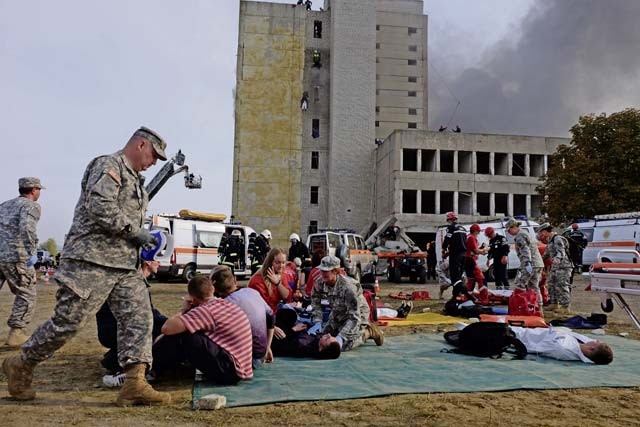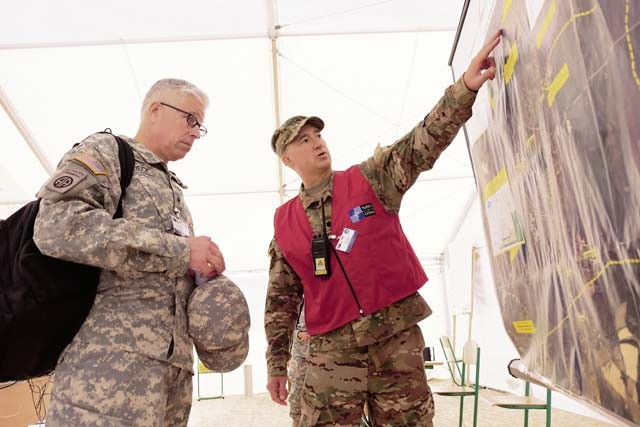
LVIV, Ukraine — Soldiers from the 7th Civil Support Command joined the Defense Threat Reduction Agency-Europe and 25 allied and partner nations as part of the U.S. Army Europe “Strong Europe” campaign. The focus gathered in support of the NATO consequence management exercise Ukraine 2015, Sept. 21 to 24.
Army Reserve Soldiers from the 7th CSC’s Headquarters and Headquarters Company, the Medical Support Unit-Europe, the 773rd Civil Support Team, the 2500th Digital Liaison Detachment and the 361st Civil Affairs Brigade participated in the Euro-Atlantic Disaster Response Coordination Center’s emergency disaster response command post and field training exercise.
In total, the 7th CSC sent 25 Soldiers to Ukraine. Overall, the exercise featured more than 1,100 participants, including over 800 Ukrainian civil emergency responders.
The mission for the 7th CSC Soldiers was to train for the planning and conducting of foreign consequence management operations in support of NATO allied and partner nations in a realistic training environment, according to Col. Tyra Harding, officer in charge of the 7th CSC effort and the U.S. Headquarters Element during Ukraine 2015.
“Three of the 7th CSC missions are foreign consequence management, humanitarian assistance and disaster response,” Harding said. “The goals for the U.S. team in this exercise were to develop relationships and interoperability.”
The 7th CSC team was able to meet its training objectives in several ways, Harding said.
“The 773rd Civil Support Team participated in various exercise scenarios with Hungary and Poland’s HAZMAT units,” she said. “In addition, the Medical Support Unit-Europe worked with emergency first responders from Spain, Moldova and Ukraine to establish a robust triage site.”
During the first two days of the exercise, the 7th CSC and units from different countries trained together, practicing tactics and techniques to learn one another’s standard operating procedures. The goal was to integrate as cohesive partner teams to respond to the exercise scenarios during the final two days.
On day three, the exercise portion began. The NATO EADRCC direct staff was in charge of creating and sending out the training events to the participants and observing their responses.
“We execute disaster scenario injects and help manage the overall conduct of the exercise,” said Lt. Col. Jason Welch, executive officer for the 2500th DLD, 7th CSC.
One of the scripted training events involved an earthquake caused by fracking. The disaster led to a mine collapse, chemical explosion and forest fire.
“We’re actually working with several different nations,” said Lt. Col. Valens Plummer, lead physician with the MSU-E.
The MSU-E worked with Ukrainian, Moldovian and Spanish emergency services, conducted initial assessments, triaged patients with simulated injuries and transported ‘patients’ from a simulated building collapse.
“It has been an excellent experience working with them (the Ukrainian search and rescue),” Plummer said.
The U.S. augmented the Ukrainians and worked as a totally integrated team, he said.
“I’ve been very pleased with the interaction we’ve had with them,” Plummer said. “One thing that I’ve actually learned is that it is possible, even though you have different languages, to be able to work together.”
An additional technology, called Telemedicine, was also tested during triage.
Telemedicine is a NATO Science for Peace and Security Programme with a solar powered satellite dish, connection to a laptop and a video streaming capable camera.
Using Telemedicine, Plummer was able to speak to a specialist in Romania, who was able to consult about the best course of treatment for a simulated patient.
Also on day three at a different location, the 773rd CST partnered with Hungarian and Polish Chemical, Biological, Radiological, and Nuclear teams to assess suspected sites lead by the Ukrainian and Armenian Search and Rescue units.
“We all have different tactics, techniques and procedures, and learning each other’s and being able to coordinate activity and work together has been outstanding,” said Staff Sgt. Shawn McKenna, a site survey team leader, 773rd CST, 7th CSC. “It’s a great learning experience for everybody, them as well as us.”
One CBRN scenario on day three saw the combined U.S. and Hungarian team conduct a site survey. They took samples from the simulated residence of a suspected hemorrhagic fever patient, which were handed over to the Polish CBRN lab for testing.
“It was very good to work together to cooperate with the American side,” said Laszlo Csok, team leader of the Hungarian CBRN team. “This mission together was successful, so I appreciate it. It enhanced the cooperation between nations. I hope that we have some similar opportunity in the future to work together again.”
Day four included a massive demonstration event with a realistic collapsed building scene straight out of a Hollywood blockbuster. It included smoke, simulated explosions, airplanes, parachute rescuers, search-and-rescue canine units and a forest fire, followed by a closing ceremony.
“Our participation in this exercise allows us to work with and develop relationships with the allied countries in a non-kinetic environment,” Harding said. “We’ve built strong bonds and communication during this realistic training scenario with our NATO allies and partner nations which will strengthen our ability to respond in the event of a real world disaster emergency response.”








